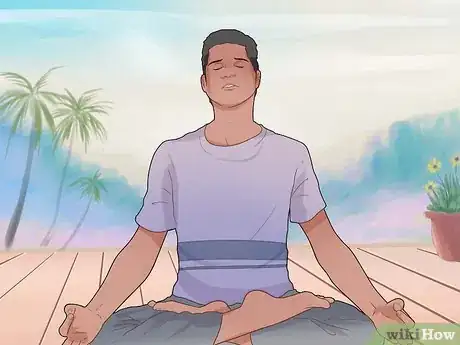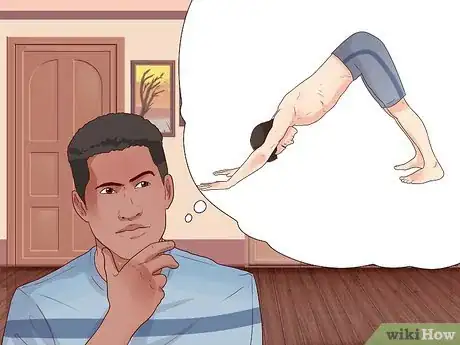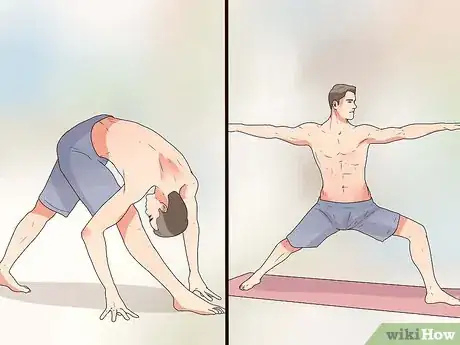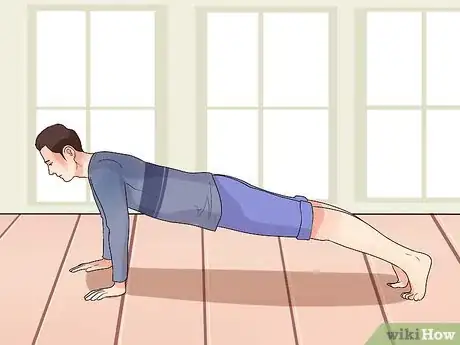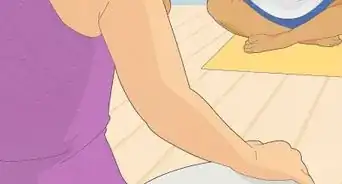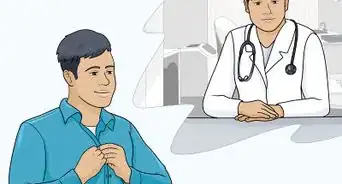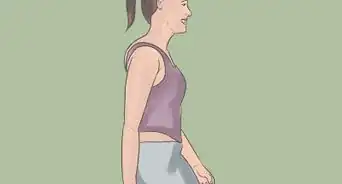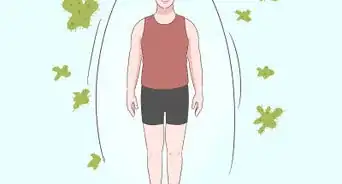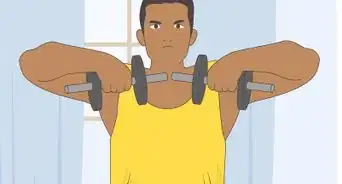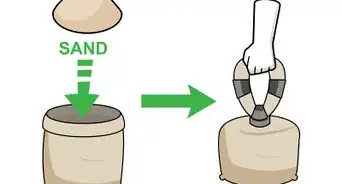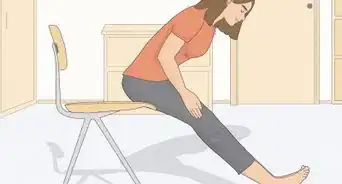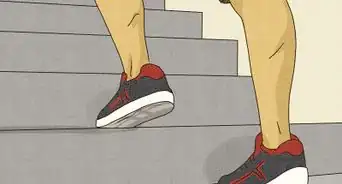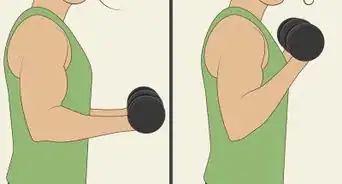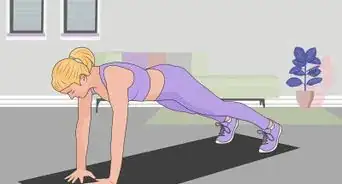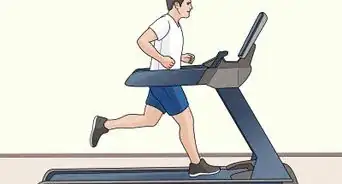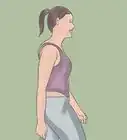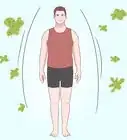This article was co-authored by Atthena Breitton, E-RYT 500. Atthena Breitton is a Yoga Alliance E-RYT 500 and Continuing Education Provider. She is the Founder & Principal Teacher of AtthenaYoga, a boutique yoga and meditation studio in New York City. She has been teaching since 2015, and some of her clients include NFL football player, Jordan Matthews, and Hip Hop Rapper, Lil Yachty. In addition to her studio, Atthena teaches and lectures around the city at major corporations such as Facebook, Ernst & Young, HSBC, U.S. Bank, and WPP. Atthena follows the path of Bhakti Yoga, a path of selfless love, devotion, and service to the Divine. Atthena holds a BS in Economics with concentrations in Finance and Management from the University of Pennsylvania.
There are 17 references cited in this article, which can be found at the bottom of the page.
wikiHow marks an article as reader-approved once it receives enough positive feedback. In this case, 99% of readers who voted found the article helpful, earning it our reader-approved status.
This article has been viewed 105,607 times.
Yoga is known for its mental and physical health benefits. It provides a routine in which you can meditate by focusing on your breathing and relaxing all of your muscles. But it can also be a great way to exercise and build up your overall fitness level and prevent future weight gain.[1] Whether you want to strengthen your core muscles or supplement your general cardio routine, practicing dynamic Fitness Yoga can help improve your overall health.[2]
Steps
Developing a Fitness Yoga Routine
-
1Practice yoga as part of your whole fitness regimen. Adults require 150 minutes of moderate aerobic activity plus two muscle strengthening workouts each week to achieve physical fitness.[3] Moderate aerobic activity includes things like walking, running, biking, and swimming. Yoga combines physical strength exercises with breathing and stretching exercises, so it is not quite the same as aerobic exercise.[4]
- Try to incorporate yoga as a strengthening exercise a couple of days per week or use it as a way to stretch and reduce stress before or after a workout.
-
2Choose yoga poses that meet your fitness needs. Yoga poses can target almost any area of your body. They can strengthen your legs, increase flexibility in your arms, and improve breath control.[5] Choose poses that will help you to work on specific fitness goals.
- For example, if you want to increase flexibility in your legs, then you might try downward facing dog pose. If you want to improve balance, then you might try a half moon pose.
Advertisement -
3Start and end with low intensity poses. Whenever you do a yoga routine, you should start by doing some low intensity poses to start and then build from there. Also, make sure that you always close your yoga routine with corpse pose to end on a relaxing note.
- For example, you might start with some sun salutations and then move into standing poses, such as Warrior pose, and backbends or headstands (if you are ready).[6]
-
4Add yoga poses that will complement your cardio workout. Doing a complementary yoga pose before and after your workout can help to speed up recovery from tough workouts. By speeding up your recovery, you will be more likely to stick with your routine and reach your goals. Try adding a couple of complementary poses to your current exercise routine.[7]
- Runners. Prepare for your routine with a pose that targets your legs such as the lying big toe or a single leg forward bend. Then you can follow up your run with a pose that stretches your legs and opens up your hip flexors, such as the Warrior II pose.
- Elliptical users. Start with a twist pose such as a sitting spinal twist. Then, follow up your workout with something that will stretch your legs and back such as a seated forward bend.
- Bike riders. Prepare for your workout with a stretch that will increase your lung capacity and stretch your arms and legs, such as a king dancer pose. Then, follow up your workout with a pose that will stretch the muscles in the front of your body, such as the camel pose.
-
5Modify yoga poses to make them harder. Increasing the intensity of your yoga poses can improve your results. Lifting up an arm or a leg or pushing the stretch a little further will make it harder. If a pose feels too easy, then try to modify it so that it is harder.[8] Ask your yoga instructor if you are not sure how to increase the intensity for a pose.
- For example, when doing downward facing dog, you can lift up a leg as high as it will go to increase the intensity of the stretch.
-
6Spend as much time as you want on your routine. Yoga classes are often an hour long or longer, but your home practice does not need to be this long if you do not have time. You can benefit from as little as 15 minutes of yoga per day. Decide what amount of time is realistic for you and use that time to work on the poses that you want to perfect.[9]
- Try doing 15 minutes of yoga before you take your morning shower or as part of your bedtime wind-down routine.
- Take a class at least once per week so that you will get to do at least one long yoga session per week.
-
7Use yoga to increase flexibility and strengthen joints. Doing yoga can help keep your muscles long and lean. This is especially beneficial if you practice a sport like football or running where you have to put significant pressure on your joints.[10]
- Yoga has been shown to help strengthen joints that often can cause pain, such as knees, hips and ankles.[11]
-
8Incorporate yoga as a cool down routine. After you exert your body with intense cardio exercises like biking or running, consider using yoga as part of an extended cool down routine. It will help your muscles stay loose and protect you from further injury.[12]
- Building up core muscle strength through exercises like yoga has been shown to improve the endurance of runners as they train for marathons.[13]
-
9Find a yoga class. While practicing poses on your own can have significant benefits, learning from a trained yoga instructor can help you find the best poses that work for your body. Look for classes offered at your local gym, community center or yoga studio.[14]
- Particularly look for classes called things like Power Yoga. These classes will focus on a constant flow between poses so your heart rate remains active. You can also try hot yoga -- in which classes are held in rooms that are heated to 101 degrees -- if you want to work up a sweat.[15]
Practicing the Right Poses
-
1Test your muscles. Although yoga will not burn as many calories as high intensity aerobic exercises (like running or swimming), it can improve your muscle strength, allowing your body to burn more calories more efficiently.[16]
- You will want to focus on poses that strengthen your core muscles in your back, shoulders and abdomen. Practicing these poses will help you tone flabby muscles and improve your overall posture.
-
2Practice Chaturanga. This yoga pose is similar to a modern push up. This pose strengthens your arms, abdominals, and upper back. It is very effective at developing your core strength. You might struggle with it at first, but the more you practice it, the easier it will be.[17] To get started, place your mat on the floor and lie face-down on it.[18]
- Put your hands under your shoulders, with your fingers pointing forward, in the same direction as your head.
- Push forward on your toes as you fully extend your arms and the rest of your body moves up from the mat.
- Keep your head and your neck in a straight line with your spine. Make sure your hips do not wobble to the side. Keep your abdominal muscles pulled in and centered while you complete this pose.
- You can do this pose with your legs extended fully behind you, so you are lifting your entire body up from the ground. If you want to modify it to an easier position, lift up from your knees.
- Watch your lower back. Don't let it stick up to the ceiling above your shoulders and don't let it dip down to the mat; keep it in a clear line with the spine, neck and head.[19]
- Repeat the process of lifting and lowering your body (without quite fully touching the mat) 10-20 times. Breathe in as you lift up and exhale as you lower back down to the mat.
-
3Try the Balancing Table Pose. Come to the floor of your mat with your knees bent on the ground and your arms underneath your shoulders. You should resemble the shape of a table with your back forming the table top and your arms and legs serving as the legs of the table.[20]
- Keep your legs hip width apart and your palms directly under your shoulders with your fingers pointed forward.
- Then, raise your right arm forward to shoulder height and your left leg out and backward. Hold both your arm and leg in an extended pose for 2 seconds. Your arm and leg should be lifted to the same height so your spine is neutral.
- Lower your right arm and left leg back into the pose so you once again resemble the shape of a table.
- Repeat these actions, but with your left arm and right leg this time.
- Alternate the combinations of lifts for 5-10 times on each side.
- This pose strengthens your abdominal and lower back muscles.
-
4Get into the Downward Facing Dog pose. In the DFD pose, your body will resemble a standing triangle. This pose strengthens your back, arms and legs. [21]
- Begin on your mat on your hands and knees, the same table-top position as described above. Your knees should be below your hips and your hands should be facing slightly forward under your shoulders.[22]
- Inhale and then push your knees up and back and your arms up and forward. Push your tailbone and butt up to the sky.[23]
- Keep your legs balanced on the balls of your feet.
- Do not round your spine as you push upward.[24]
- Hold the pose for 1-3 minutes depending on the strength of your core muscles, arms and legs.[25]
- Exhale as you bring your body back into a table top position. Lower your arms and bring your legs back to the ground so they are underneath your hips again.
-
5Complete the Bow Pose. The Bow pose is great for strengthening the muscles in your back, legs, butt and shoulders. It is generally used by more advanced practitioners, so don't be discouraged if you are a beginner and have trouble completing it.
- Lie down on your mat on your stomach with your face toward the ground.
- Bend your legs at the knees. Reach your arms backwards to grab your feet.
- Raise your upper body and extend your feet upward, so you form the curved shape of a bow.
- Keep your stomach pulled inward. Make sure your shoulder blades are not raised up by your ears, but are down and back.
-
6Attempt the Warrior I Pose. The Warrior I pose is a full body test, strengthening your abs, thighs and arms.
- Start in a standing position with feet placed underneath your hips, feet next to each other.
- Place your left leg 4–5 feet (1.2–1.5 m) to the left of your right leg. Then rotate your feet and your torso so you are now facing left.
- Bend your left knee so it extends over your left toes. Keep your right leg straight behind you.
- Reach your arms upward to the sky, finger tips pointed upward. Let your eyes follow your fingers.
- Hold the pose for 30 seconds and repeat 5-6 times.
Remaining Mindful with Yoga
-
1Reduce your stress levels. Yoga is commonly practiced as a way of managing stress or anxiety. Yoga can have enormous benefits in this arena by giving you a sense of inner peace and calm.
- Studies have shown that practicing yoga 2-3 times a week significantly improved the psychosocial well-being of high school students.[26]
-
2Become mindful about your body. Even if yoga does not make you lose weight at a rapid pace, it can help you maintain an effective weight loss plan. It can help you simply move more frequently, increase blood circulation and improve flexibility. With yoga, you become more aware of how your body works and responds to physical exercise.[27]
-
3Embrace the power of meditation. A key component of mindful exercise is meditation. With meditation, you reflect on what your body can accomplish and how it should best rest from a workout.
- On your mat, rest in a sitting position cross-legged. Put your hands in your lap (or on the legs). Keep your back straight and the belly relaxed.
- Chant the mantra "Om Shanti" until your mind comes to rest. Move your hand and think, "I send light to (name). May all people be happy. May the world be happy."
Expert Q&A
Did you know you can get expert answers for this article?
Unlock expert answers by supporting wikiHow
-
QuestionHow often should you practice yoga?
 Atthena Breitton, E-RYT 500Atthena Breitton is a Yoga Alliance E-RYT 500 and Continuing Education Provider. She is the Founder & Principal Teacher of AtthenaYoga, a boutique yoga and meditation studio in New York City. She has been teaching since 2015, and some of her clients include NFL football player, Jordan Matthews, and Hip Hop Rapper, Lil Yachty. In addition to her studio, Atthena teaches and lectures around the city at major corporations such as Facebook, Ernst & Young, HSBC, U.S. Bank, and WPP. Atthena follows the path of Bhakti Yoga, a path of selfless love, devotion, and service to the Divine. Atthena holds a BS in Economics with concentrations in Finance and Management from the University of Pennsylvania.
Atthena Breitton, E-RYT 500Atthena Breitton is a Yoga Alliance E-RYT 500 and Continuing Education Provider. She is the Founder & Principal Teacher of AtthenaYoga, a boutique yoga and meditation studio in New York City. She has been teaching since 2015, and some of her clients include NFL football player, Jordan Matthews, and Hip Hop Rapper, Lil Yachty. In addition to her studio, Atthena teaches and lectures around the city at major corporations such as Facebook, Ernst & Young, HSBC, U.S. Bank, and WPP. Atthena follows the path of Bhakti Yoga, a path of selfless love, devotion, and service to the Divine. Atthena holds a BS in Economics with concentrations in Finance and Management from the University of Pennsylvania.
Yoga Instructor & Educator
-
QuestionWhich yoga is best for fitness?
 Atthena Breitton, E-RYT 500Atthena Breitton is a Yoga Alliance E-RYT 500 and Continuing Education Provider. She is the Founder & Principal Teacher of AtthenaYoga, a boutique yoga and meditation studio in New York City. She has been teaching since 2015, and some of her clients include NFL football player, Jordan Matthews, and Hip Hop Rapper, Lil Yachty. In addition to her studio, Atthena teaches and lectures around the city at major corporations such as Facebook, Ernst & Young, HSBC, U.S. Bank, and WPP. Atthena follows the path of Bhakti Yoga, a path of selfless love, devotion, and service to the Divine. Atthena holds a BS in Economics with concentrations in Finance and Management from the University of Pennsylvania.
Atthena Breitton, E-RYT 500Atthena Breitton is a Yoga Alliance E-RYT 500 and Continuing Education Provider. She is the Founder & Principal Teacher of AtthenaYoga, a boutique yoga and meditation studio in New York City. She has been teaching since 2015, and some of her clients include NFL football player, Jordan Matthews, and Hip Hop Rapper, Lil Yachty. In addition to her studio, Atthena teaches and lectures around the city at major corporations such as Facebook, Ernst & Young, HSBC, U.S. Bank, and WPP. Atthena follows the path of Bhakti Yoga, a path of selfless love, devotion, and service to the Divine. Atthena holds a BS in Economics with concentrations in Finance and Management from the University of Pennsylvania.
Yoga Instructor & Educator The sun salutation sequence is a great option that will get your heart rate up. Start by standing up straight with your arms down by your side and feet together. Inhale and reach your arms up to the sky, palms meet overhead. Exhale, open the arms, and fold forward. Reach your hands down towards the ground and keep your legs straight if you can. Inhale and flatten your back by bringing your hands onto your shins. Reach the crown of your head forward and your tailbone back so your back is nice and flat and your legs are straight. Exhale and bend your knees, plant your hands on the ground, and step back into a high plank pose. Shift your elbows past your wrist about 1 in (2.5 cm) and bend your elbows halfway down (into a 90° angle) to go into a chaturanga. Inhale and pull your chest forward as you straighten your arms. You should be on the tops of your feet (try not to sickle your foot) and try to keep your knees and thighs off the mat. Exhale and lift your hips up into a downward-facing dog. Stay in downward-facing dog for at least one full breath. Inhale, lift your heels, bend your knees, and look forward. Walk, step, or jump forward to the top of the mat (land with your feet together in between your hands) and lift into a flat back. Exhale and fold forward over your legs. Inhale, reach your arms up over your head, and come up to stand. Exhale, bring your hands to your heart in prayer, then release your hands back down by your side. Repeat this at least 5 times.
The sun salutation sequence is a great option that will get your heart rate up. Start by standing up straight with your arms down by your side and feet together. Inhale and reach your arms up to the sky, palms meet overhead. Exhale, open the arms, and fold forward. Reach your hands down towards the ground and keep your legs straight if you can. Inhale and flatten your back by bringing your hands onto your shins. Reach the crown of your head forward and your tailbone back so your back is nice and flat and your legs are straight. Exhale and bend your knees, plant your hands on the ground, and step back into a high plank pose. Shift your elbows past your wrist about 1 in (2.5 cm) and bend your elbows halfway down (into a 90° angle) to go into a chaturanga. Inhale and pull your chest forward as you straighten your arms. You should be on the tops of your feet (try not to sickle your foot) and try to keep your knees and thighs off the mat. Exhale and lift your hips up into a downward-facing dog. Stay in downward-facing dog for at least one full breath. Inhale, lift your heels, bend your knees, and look forward. Walk, step, or jump forward to the top of the mat (land with your feet together in between your hands) and lift into a flat back. Exhale and fold forward over your legs. Inhale, reach your arms up over your head, and come up to stand. Exhale, bring your hands to your heart in prayer, then release your hands back down by your side. Repeat this at least 5 times.
References
- ↑ http://www.webmd.com/fitness-exercise/yoga-for-weight-loss?page=2
- ↑ http://www.mayoclinic.org/healthy-lifestyle/weight-loss/expert-answers/yoga-for-weight-loss/faq-20057754
- ↑ http://www.cdc.gov/physicalactivity/basics/adults/
- ↑ http://www.mayoclinic.org/healthy-lifestyle/stress-management/in-depth/yoga/art-20044733
- ↑ http://www.mayoclinic.org/healthy-lifestyle/stress-management/in-depth/yoga/art-20044733
- ↑ http://www.yogajournal.com/article/practice-section/if-you-build-it/
- ↑ http://www.prevention.com/fitness/yoga-poses-better-gym-workout
- ↑ http://www.prevention.com/fitness/top-yoga-poses-weight-loss
- ↑ http://www.yogajournal.com/article/practice-section/home-stretch/
- ↑ http://www.fitday.com/fitness-articles/fitness/body-building/the-benefits-of-adding-yoga-to-a-training-routine.html
- ↑ http://www.fitday.com/fitness-articles/fitness/body-building/the-benefits-of-adding-yoga-to-a-training-routine.html
- ↑ http://www.mayoclinic.org/healthy-lifestyle/weight-loss/expert-answers/yoga-for-weight-loss/faq-20057754
- ↑ http://journals.lww.com/nsca-jscr/Abstract/2009/01000/Does_Core_Strength_Training_Influence_Running.22.aspx
- ↑ http://greatist.com/move/beginners-power-yoga
- ↑ http://www.fitday.com/fitness-articles/fitness/body-building/the-benefits-of-adding-yoga-to-a-training-routine.html
- ↑ http://www.prevention.com/fitness/top-yoga-poses-weight-loss
- ↑ http://www.mindbodygreen.com/0-6631/How-to-Do-Chaturanga-the-Right-Way.html
- ↑ http://www.mindbodygreen.com/0-6631/How-to-Do-Chaturanga-the-Right-Way.html
- ↑ http://www.prevention.com/fitness/top-yoga-poses-weight-loss
- ↑ https://www.yogabasics.com/asana/table-pose/
- ↑ http://www.yogajournal.com/pose/downward-facing-dog/
- ↑ http://www.yogajournal.com/pose/downward-facing-dog/
- ↑ http://www.yogajournal.com/pose/downward-facing-dog/
- ↑ http://www.yogajournal.com/pose/downward-facing-dog/
- ↑ http://www.yogajournal.com/pose/downward-facing-dog/
- ↑ http://journals.lww.com/jrnldbp/Abstract/2012/04000/Benefits_of_Yoga_for_Psychosocial_Well_Being_in_a.1.aspx
- ↑ http://mipsm.org/site/wp-content/uploads/2013/11/Yoga-July-Aug-2005.pdf
About This Article
To do yoga for fitness, you’ll need to develop a routine that works for you. For example, if you’re interested in building strength in your legs, start with poses that focus on your lower body. Begin with low-intensity poses if you’re new to yoga so you don’t injure yourself. As you get more confident, you can start adding new poses or modifying your favorite poses so they’re more challenging. If you already have a workout routine, incorporate yoga into it. For instance, use yoga to cool down after running. You can benefit from as little as 15 minutes of yoga per day, so don’t worry if you don’t have the time for a long daily practice. For more expert tips, like how to choose the best poses, keep reading!
